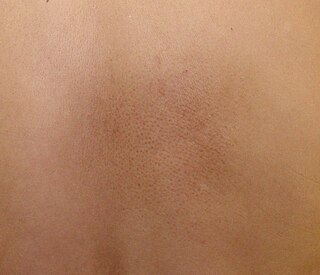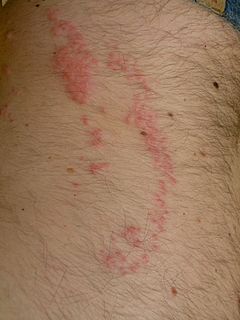Related Research Articles
A skin condition, also known as cutaneous condition, is any medical condition that affects the integumentary system—the organ system that encloses the body and includes skin, hair, nails, and related muscle and glands. The major function of this system is as a barrier against the external environment.

Lichen planus (LP) is a chronic inflammatory and immune-mediated disease that affects the skin, nails, hair, and mucous membranes. It is not an actual lichen, and is only named that because it looks like one. It is characterized by polygonal, flat-topped, violaceous papules and plaques with overlying, reticulated, fine white scale, commonly affecting dorsal hands, flexural wrists and forearms, trunk, anterior lower legs and oral mucosa. Although there is a broad clinical range of LP manifestations, the skin and oral cavity remain as the major sites of involvement. The cause is unknown, but it is thought to be the result of an autoimmune process with an unknown initial trigger. There is no cure, but many different medications and procedures have been used in efforts to control the symptoms.
Haemodialysis-associated amyloidosis is a form of systemic amyloidosis associated with chronic kidney failure.

Primary cutaneous amyloidosis is a form of amyloidosis associated with oncostatin M receptor. This type of amyloidosis has been divided into the following types:
Primary inoculation tuberculosis is a skin condition that develops at the site of inoculation of tubercle bacilli into a tuberculosis-free individual.
Tuberculosis cutis orificialis is a form of cutaneous tuberculosis that occurs at the mucocutaneous borders of the nose, mouth, anus, urinary meatus, and vagina, and on the mucous membrane of the mouth or tongue.

Cutaneous small-vessel vasculitis (CSVV), also known as hypersensitivity vasculitis, cutaneous leukocytoclastic vasculitis, hypersensitivity angiitis, cutaneous leukocytoclastic angiitis, cutaneous necrotizing vasculitis and cutaneous necrotizing venulitis, is inflammation of small blood vessels, characterized by palpable purpura. It is the most common vasculitis seen in clinical practice.
Silicone granulomas are a skin condition that occur as a reaction to liquid silicones, and are characterized by the formation of nodules.
Paraneoplastic acrokeratosis, or Bazex syndrome is a cutaneous condition characterized by psoriasiform changes of hands, feet, ears, and nose, with involvement of the nails and periungual tissues being characteristic and indistinguishable from psoriatic nails. The condition is associated with carcinomas of the upper aerodigestive tract.
Cutaneous actinomycosis is a chronic disease that affects the deep subcutaneous tissue of the skin. Caused by an anaerobic, Gram-positive, filamentous type of bacteria in the genus Actinomyces, invasion of the soft tissue leads to the formation of abnormal channels leading to the skin surface that discharge pale yellow sulfur granules.

Jellyfish dermatitis is a cutaneous condition caused by stings from a jellyfish.

Cutaneous lymphoid hyperplasia refers to a groups of benign cutaneous disorders characterized by collections of lymphocytes, macrophages, and dendritic cells in the skin. Conditions included in this groups are:

Secondary systemic amyloidosis is a condition that involves the adrenal gland, liver, spleen, and kidney as a result of amyloid deposition due to a chronic disease such as Behçet's disease, ulcerative colitis, etc.
Heredofamilial amyloidosis is an inherited condition that may be characterized by systemic or localized deposition of amyloid in body tissues.
A diabetic bulla is a cutaneous condition characterized by a noninflammatory, spontaneous, painless blister, often in acral locations, seen in diabetic patients.
Diabetic dermadromes constitute a group of cutaneous conditions commonly seen in people with diabetes with longstanding disease. Conditions included in this group are:
Median raphe cysts are a cutaneous condition of the penis due to developmental defects near the glans.

Familial Amyloidosis, Finnish Type (FAF), also called hereditary gelsolin amyloidosis and AGel amyloidosis (AGel), is an amyloid condition with a number of associated cutaneous and neurological presentations deriving from the aberrant proteolysis of a mutated form of plasma gelsolin. First described in 1969 by the Finnish ophthalmologist Jouko Meretoja, FAF is uncommon with 400-600 cases described in Finland and 15 elsewhere.
References
- ↑ James, William D.; Berger, Timothy G.; et al. (2006). Andrews' Diseases of the Skin: clinical Dermatology. Saunders Elsevier. ISBN 978-0-7216-2921-6.
- ↑ Rapini, Ronald P.; Bolognia, Jean L.; Jorizzo, Joseph L. (2007). Dermatology: 2-Volume Set. St. Louis: Mosby. ISBN 978-1-4160-2999-1.
| This cutaneous condition article is a stub. You can help Wikipedia by expanding it. |